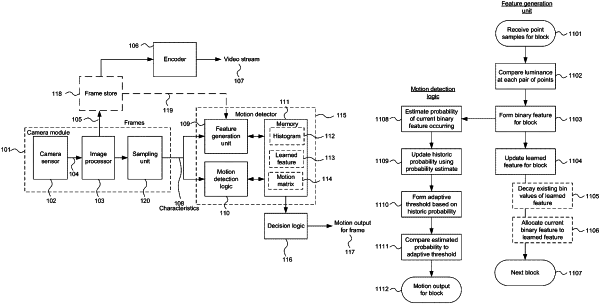| CPC G06T 7/246 (2017.01) [G06F 18/22 (2023.01); G06V 40/20 (2022.01); G06T 2207/20021 (2013.01); G06T 2207/20081 (2013.01)] | 20 Claims |

|
1. A data processing device configured to detect motion in a sequence of frames each comprising one or more blocks of pixels, the data processing device comprising:
a sampling unit configured to determine image characteristics at a set of sample points of a block in a current frame of said sequence;
a feature generation unit configured to form a current feature for the block in dependence on the determined image characteristics, the current feature having a plurality of values derived from the sample points; and
motion detection logic configured to generate a motion output for the block by comparing the current feature for the block to a learned feature representing historical feature values for the block in frames of said sequence previous to said current frame, wherein said comparing comprises:
maintaining an estimate of an expected degree of variation of the block;
forming an adaptive threshold for the block in dependence on that estimate;
forming an estimate as to whether, based on a measure of differences between the values of the current feature and the corresponding values of the learned feature, the current feature is expected based on the historical values of the learned feature of the block; and
generating the motion output so as to indicate motion at the block if the estimate exceeds the adaptive threshold.
|